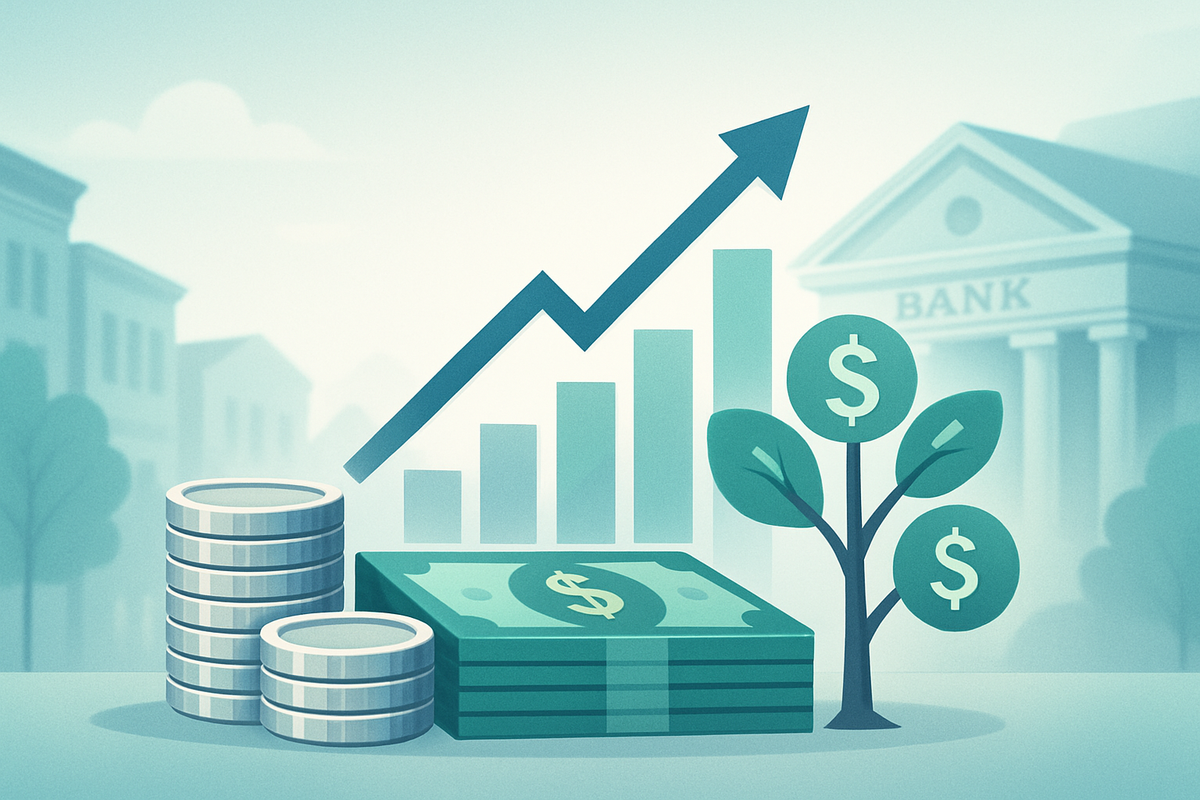
Union Bankshares (NASDAQ: UNB) has announced a quarterly cash dividend of $0.36 per share, signaling continued commitment to shareholder returns. This declaration comes on the heels of a robust third quarter for 2025, where the company reported a significant surge in net income and overall asset growth. The consistent dividend payout, coupled with strong financial performance, positions UNB as a stable, income-generating option for investors, even as some analysts ponder its long-term dividend growth trajectory.
Detailed Coverage of the Dividend Declaration
The Board of Directors of Union Bankshares (NASDAQ: UNB) officially declared its regular quarterly cash dividend of $0.36 per share on October 15, 2025. Shareholders of record as of October 25, 2025, will be eligible for the payment, with the ex-dividend date set for October 23, 2025, and the actual payment scheduled for November 6, 2025. This maintains the dividend at its current level, which has been consistent since Q1 2023.
The dividend announcement is underpinned by Union Bankshares' impressive financial results for the third quarter of 2025. The company reported a consolidated net income of $3.4 million, a substantial increase from $1.3 million in the same period last year. This growth was fueled by a disciplined approach to asset expansion, effective expense management, and a resilient loan portfolio. Total assets climbed to $1.57 billion, driven by a 5.1% increase in loans, while net interest income rose by 18.3% to $11.2 million. The company's book value per share also saw a healthy 6.1% increase, reaching $16.95.
Initial market reactions have been largely positive, reflecting the company's solid Q3 performance. TipRanks' AI Analyst has rated UNB as "Outperform," highlighting its strong financials and attractive valuation, though noting high leverage as a risk. One analyst has issued a "Buy" rating with a price target of $29.00. However, some earlier analyst commentary from July and August 2025 has introduced a more nuanced perspective, questioning the sustainability of dividend growth, despite the current $0.36 payout being deemed sustainable with a 74% payout ratio. Concerns have been raised about the company's earnings per share declining by 3.2% annually over the past five years and its heavy concentration in real estate loans, which could expose it to regional economic risks.
Company Impact: Winners and Losers
Union Bankshares' (NASDAQ: UNB) decision to declare a $0.36 per share quarterly cash dividend amidst robust growth creates a clear set of winners and losers, influencing various stakeholders within and beyond the regional banking sector.
Union Bankshares (NASDAQ: UNB) Itself: The bank largely emerges as a winner. The consistent dividend payment, especially when coupled with strong Q3 2025 financial results, enhances its reputation as a stable and well-managed financial institution. This can attract a broader base of investors, including those with income mandates, potentially leading to a lower cost of equity for UNB. It also reinforces its market positioning as a mature company capable of both business growth and shareholder returns. The primary "cost" is a reduction in retained earnings, which could otherwise be fully reinvested. However, the reported growth suggests a balanced capital allocation strategy that isn't significantly hindering critical expansion.
UNB Shareholders: These are immediate beneficiaries. They receive a direct income stream, highly attractive to income-focused investors. The dividend declaration, alongside strong earnings, signals positive future prospects, which can lead to an improved stock price as investor sentiment strengthens. Over the long term, consistent dividends contribute significantly to total shareholder return and can stabilize stock price during market volatility. The main "loss" for shareholders is the tax implication on dividend income, and for those solely focused on aggressive capital appreciation, an argument could be made that funds could be entirely reinvested for potentially higher, albeit riskier, future growth.
Competitors in the Regional Banking Sector: The impact here is mixed. On one hand, UNB's strong performance and dividend payout could contribute to a generally positive perception of the regional banking sector, potentially benefiting other stable regional banks by attracting broader investor interest. It also validates the community-focused banking model. On the other hand, UNB's ability to maintain a consistent dividend while growing puts pressure on regional competitors. Smaller or less robust firms may feel compelled to initiate or increase their own dividends to remain competitive for investor capital, even if it strains their financial resources or growth initiatives. This could lead to inefficient capital allocation for those unable to match UNB's underlying financial strength. Examples of regional competitors include BancorpSouth Bank (NYSE: BXS) or First Horizon Corporation (NYSE: FHN), who might face indirect competitive pressure.
Other Financial Institutions: For large, diversified financial institutions or those operating in different market segments, UNB's dividend declaration is unlikely to have a significant direct negative impact. Their competitive positioning and capital allocation strategies are driven by a broader set of factors. However, it does contribute to the overall narrative of a healthy and stable financial system, particularly within the banking sector, which can lead to marginal positive sentiment for all financial institutions.
Wider Significance of the Event
Union Bankshares' (NASDAQ: UNB) declaration of a $0.36 per share quarterly cash dividend, particularly amidst reported financial growth, carries significant weight within the regional banking sector. This event not only highlights UNB's individual health but also intersects with broader industry trends, including consolidation, the evolving interest rate environment, and ongoing regulatory shifts, creating potential ripple effects across competitors and partners.
Fitting into Broader Industry Trends: UNB's ability to maintain a stable and attractive dividend while achieving growth positions it favorably in an industry characterized by consolidation. The U.S. banking sector is seeing increasing mergers and acquisitions (M&A) as regional banks seek scale and diversification. UNB's robust financial health and consistent dividend could make it an appealing target for larger institutions or a stronger consolidator itself, depending on its strategic direction. The current interest rate environment, marked by elevated rates with anticipated gradual declines, presents both opportunities and challenges. UNB's reported growth in loan activity suggests effective balance sheet management, allowing it to thrive despite these conditions. Looking ahead, prospective rate cuts could further boost net interest margins by lowering deposit costs faster than loan yields, stimulating borrowing demand and improving overall profitability for well-positioned regional banks like UNB.
Potential Ripple Effects on Competitors and Partners: UNB's strong performance and dividend payout set a positive precedent, particularly for well-managed regional banks. It can enhance investor confidence in the sector and potentially draw investment away from less stable peers. Regional banks with strong dividend growth streaks, such as Arrow Financial Corporation (NASDAQ: AROW) or Community Financial System, Inc. (NASDAQ: CFOS), offer similar appeal to income-oriented investors. Conversely, smaller or struggling competitors might face increased pressure to initiate or raise their own dividends to remain competitive for investor capital, even if it strains their financial resources or growth initiatives. This could lead to inefficient capital allocation for those unable to match UNB's underlying financial strength. For its community partners—local businesses and residential lending clients in northern Vermont and northwestern New Hampshire—UNB's robust financial health instills confidence, ensuring continued access to essential banking services and support for local economies.
Regulatory or Policy Implications: While UNB's dividend decision is internal, it operates within a stringent regulatory framework. The ability to confidently declare this dividend indicates that UNB comfortably meets its capital requirements. Regulatory bodies have the authority to restrict dividend payouts, especially during economic uncertainty or if capital requirements are breached. Discussions around easing capital requirements for smaller banks (e.g., under the Basel III Endgame re-proposal) could generally favor banks' ability to return capital to shareholders. However, the failures of some regional banks in 2023 underscore that supervisory intensity for regional institutions remains high, suggesting that regulatory scrutiny on capital and risk management will persist despite any broader deregulation trends. UNB's strong asset quality and improved stockholder equity position it favorably in this regard, demonstrating adherence to crucial regulatory standards.
Historical Precedents and Comparisons: Historically, regional banks have been a reliable source of dividend income, valued for their stable cash flows. Maintaining or increasing dividends during growth or even uncertainty serves as a signal of strength, as seen during the 2007-2009 financial crisis where some banks continued payouts to project stability (though regulators can intervene). UNB's track record of stable dividends for over a decade aligns with this tendency of well-managed regional banks to prioritize shareholder returns. The current environment, with its "higher-for-longer" interest rate outlook and prospects of regulatory tailwinds, draws comparisons to periods like the mid-1990s, where similar monetary policy shifts positively impacted bank outlooks.
What Comes Next for Union Bankshares and the Market
Union Bankshares' (NASDAQ: UNB) recent declaration of a $0.36 per share quarterly cash dividend, underpinned by robust Q3 2025 growth, sets the stage for a dynamic period ahead. The bank, along with the broader regional banking sector, will navigate a complex interplay of interest rate changes, evolving economic conditions, and an increasingly competitive landscape.
Short-Term and Long-Term Possibilities: In the short term, UNB is well-positioned for continued profitability, particularly from its net interest income, especially if interest rates stabilize or decline gradually. The consistent dividend, maintained for 28 consecutive years, is likely to bolster shareholder confidence and attract income-focused investors, providing a degree of stock price stability. The healthy 5.1% year-over-year loan growth suggests continued expansion in its loan portfolio. Long-term, UNB could expand its market share by leveraging its community connections and local expertise to target niche markets in northern Vermont and New Hampshire. Strategic investments in digital transformation will be crucial to enhance customer engagement and operational efficiency, enabling it to compete effectively against larger, tech-savvy institutions. Given the ongoing consolidation in the regional banking sector, UNB might also engage in strategic acquisitions to expand its footprint and capabilities. Diversifying revenue streams beyond traditional net interest income, such as through wealth management or fee-based services, could also provide greater resilience against future interest rate volatility.
Potential Strategic Pivots or Adaptations Required: To ensure sustained success, UNB and its regional peers will need to adapt strategically. Prioritizing significant investment in modern digital banking platforms, mobile applications, and AI will be essential to meet evolving customer expectations. Focusing on niche market specialization, where local expertise offers a distinct advantage, can help differentiate it from national banks. Proactive risk management, particularly concerning its commercial real estate (CRE) portfolio, will be crucial given sector-wide concerns. Developing agile deposit strategies to attract and retain low-cost deposits will also be vital in a competitive funding environment. Leveraging its smaller size for faster decision-making and rapid adaptation to market shifts and regulatory changes will be a key competitive advantage.
Market Opportunities and Challenges: Opportunities abound, particularly if the Federal Reserve enters a monetary easing cycle. Interest rate cuts could boost regional banks' net interest margins as deposit costs typically adjust downwards faster than loan yields, also stimulating borrowing demand. The current attractive valuations of regional bank stocks present compelling investment opportunities. The consolidation trend offers UNB avenues for growth through strategic M&A. However, significant challenges persist. Interest rate volatility remains a double-edged sword; rapid hikes can squeeze margins by increasing funding costs, while steep drops can compress them if loan yields fall faster than deposit costs. The distressed CRE sector, especially office loans, poses a substantial risk of loan losses for many regional banks. Intense competition from larger national banks, innovative FinTech companies, and non-bank lenders will continue to demand innovation and differentiation from UNB. Deposit competition and potential flight to larger, more liquid institutions also remain a concern.
Potential Scenarios and Outcomes: An optimistic scenario envisions a "Goldilocks economy" with stable growth and gradual rate declines, allowing UNB to expand net interest margins, maintain healthy loan demand, and potentially increase dividends. A challenging scenario involving an economic slowdown or recession could lead to weakened loan demand, deteriorating credit quality, and reduced profitability, potentially pressing the dividend despite UNB's consistent history. An interest rate volatility scenario with unpredictable swings in rates could make balance sheet management difficult, impacting earnings stability. UNB's ability to navigate these scenarios will depend on its strategic foresight and operational agility.
The impact of future interest rate changes, economic conditions, and the competitive landscape will be paramount. While rising rates can initially boost interest income, they also raise deposit costs, often at a faster pace. Conversely, falling rates can expand margins if deposit costs decline more rapidly than loan yields. A strong economy generally leads to increased loan demand and better credit quality, while downturns can reverse these trends. The ongoing competitive pressures will force UNB to continuously innovate and leverage its strengths in local access and personalized service, while strategically investing in technology to enhance its digital offerings.
Comprehensive Wrap-up and Investor Outlook
Union Bankshares' latest dividend declaration, supported by impressive Q3 2025 results, firmly establishes its position as a resilient regional bank amidst a generally favorable market outlook for the sector.
Summary of Key Takeaways: The core takeaway is UNB's demonstrated financial strength, evidenced by significant growth in net income, assets, and loans for Q3 2025. This robust performance underpins the consistent $0.36 quarterly dividend, signaling management's confidence and commitment to shareholder returns. The bank's prudent expense management, resilient loan portfolio, and improved book value per share further reinforce its solid foundation.
Assessment of the Market Moving Forward: The broader regional banking sector is showing resilience, with positive signs like successful stress tests and anticipated tailwinds such as a steepening yield curve and increased loan activity. M&A acceleration is also expected, potentially driven by a more favorable regulatory environment. Regional bank stocks are currently trading at attractive valuations, with projected mid-to-high teens EPS growth for 2025 and 2026. However, vigilance is required regarding rising noninterest expenses and liquidity management.
Final Thoughts on Significance and Lasting Impact: UNB's sustained dividend, backed by strong financials, sends a powerful message of stability and investor-centricity. This performance, marked by healthy growth and proactive risk management, positions UNB favorably in the competitive regional banking landscape. The strengthening equity base, reflected in the rising book value per share, is a crucial indicator for long-term investor confidence. For income-focused investors, UNB's financial health and consistent dividend could make it a compelling component of a diversified portfolio.
What Investors Should Watch For in Coming Months: Investors should closely monitor several factors:
- Loan Growth and Asset Quality: While growth is positive, continuous assessment of loan portfolio quality and credit loss allowances is vital.
- Net Interest Margin (NIM) Evolution: Track how NIM responds to interest rate changes and funding costs, as it directly impacts profitability.
- Expense Management: Keep an eye on noninterest expenses, particularly salaries, to ensure they remain controlled.
- Loan-to-Deposit Ratio: An earlier observation highlighted this ratio as an area for potential improvement; its trend will be important.
- Regional Banking Sector Dynamics: Stay informed on M&A activity, regulatory shifts, and broader macroeconomic indicators influencing the sector.
- Analyst Sentiment and Price Targets: Monitor any revisions to analyst ratings and price targets, which can offer insights into short-term outlooks.
- Dividend Sustainability: With a payout ratio around 70-71%, sustained strong performance is essential for the long-term viability and potential growth of the dividend.
This content is intended for informational purposes only and is not financial advice




